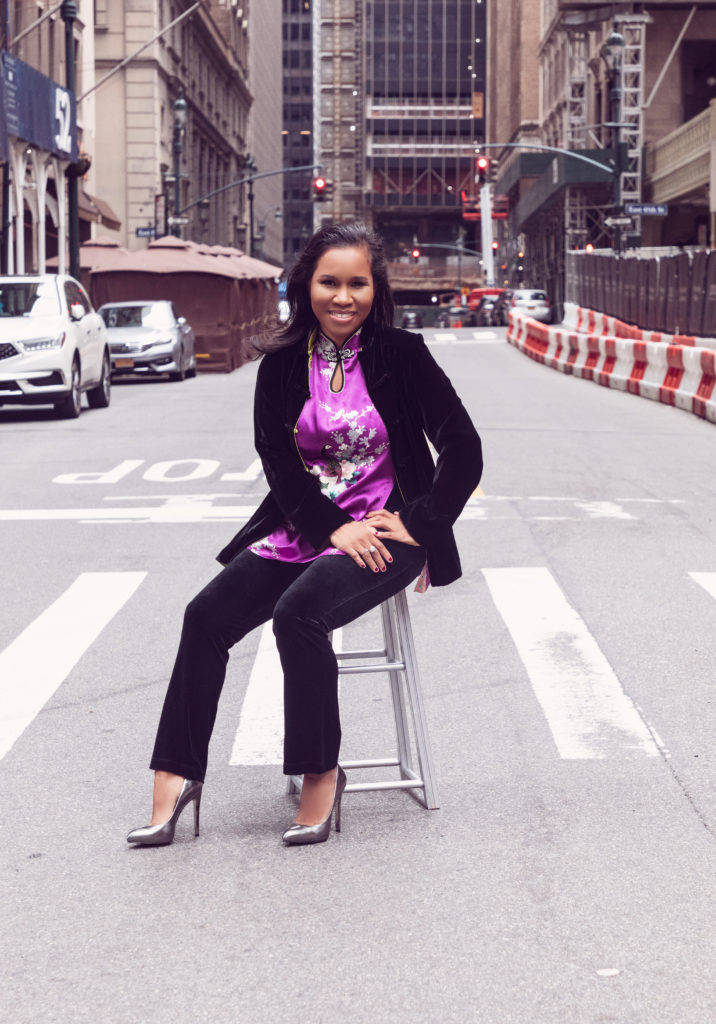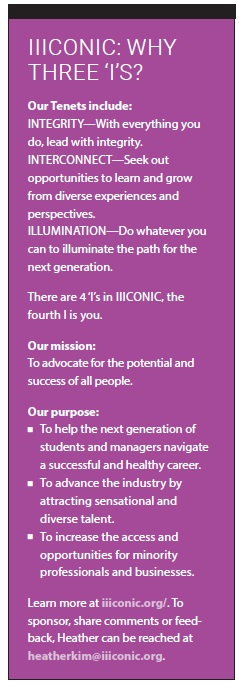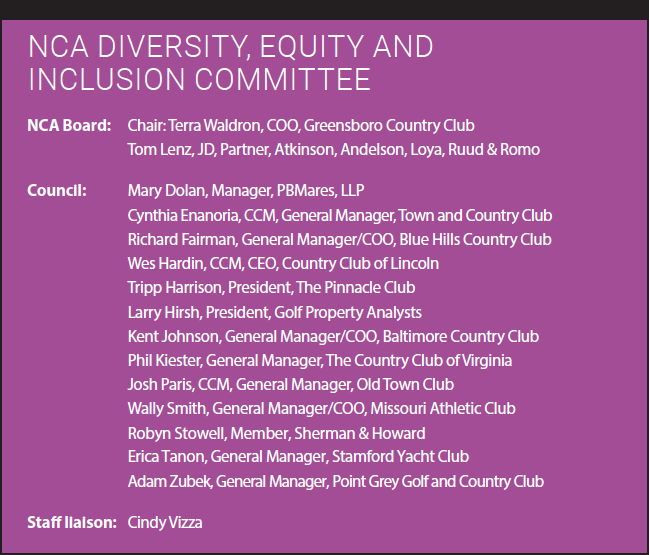
What does diversity, equity and inclusion (DEI) have to do with private clubs? As noted in “The Business Case for Diversity,” there is a business case to be made for organizations with diverse representation on their boards, within their membership, among their staff and leadership. Truly private clubs have a long history—supported by Supreme Court decisions and protections afforded under the First and Fourth Amendments of the U.S. Constitution—to the right to choose with whom one associates. However, there are many levels of diversity and many opportunities to be diverse within the private club community that do not preclude privacy rights and protections. NCA and the DEI Committee will expand the dialog about ways in which each club can approach this issue.
Outreach from a former club employee and now volunteer DEI consultant further advanced NCA’s plans to assess the club community’s DEI engagement level through a national survey, identify the challenges to implementing DEI initiatives, and begin an exchange on ways in which NCA can assist clubs interested in becoming more inclusive. NCA has formed a new Diversity, Equity and Inclusion Committee (see box for members) that has developed a set of definitions to describe DEI terms as they apply to the private club community and to develop priorities for initiatives to assist the private club community.
Let’s begin with introducing Heather Kim Degenhardt-Stifanic, founder of IIICONIC, an inclusion and diversity-focused nonprofit consulting organization.
Q. Tell us about yourself, your background and family.
A. I was adopted from Danang, Vietnam as an infant by my parents Edwin and Dawn Degenhardt. My father is of German descent and my mother is of French, Scottish and British descent. I have eight siblings, all adopted, with multicultural ancestries of Vietnamese, Indian, Chinese, Korean, Sioux Native American, European, Jewish and African descent. Our family lived in Cleveland, Ohio, until my father was approved as an owner/operator for the first of five McDonald’s restaurants in northern Maine. I grew up in the fast-food universe and worked in the restaurants from age 8 through college. I attended the culinary arts program at Southern Maine College then transferred and graduated from Johnson & Wales University’s hospitality program in Providence, R.I. I completed my college internship at the Ocean Reef Club in Key Largo, Fla., and am certified in macrobiotic studies from the Kushi Institute in Becket, Mass.
Q. You have had an interesting career—especially with private clubs. Tell us about your work in the hospitality industry.
A. The first 13 years of my hospitality career was in hotel operations. I managed restaurants, stewarding and housekeeping with Marriott International, The Ritz Carlton Hotel Company and Global Hyatt Corporation. I transitioned into human resources with Hyatt as a human resources coordinator, then employee relations manager, training manager and finally as director of service training and education. The last 13 years of my career was as human resources manager for the Yale Club of New York City and ended as their assistant human resources director. My human resources experience specialized in employee relations, training and development, hiring, safety/compliance and the facilitation of all employee volunteer and community events.

Q. What was your experience with diversity in the club workforce? How diverse is the makeup of management staff? Hourly workers?
A. Not until I joined the Yale Club did race and gender come to the forefront of my career consciousness. I felt obligated to address issues that were important—and very personal to me—including diversity, equity and fair application of club policies at every level. The line staff represented many creeds and cultures from around the world. My definition of DEI is feeling safe to express my thoughts, being made to feel included and being valued. One of the challenges at clubs is how to leverage diversity in the best way to advance the workplace.
Q. You recently orchestrated the National Club Association’s “Inclusivity Research Survey for Private Clubs.” How did you come to work with NCA?
A. During the summer, I was moved by the public outcry and solidarity to bring attention to the racial inequities for people of color. I conducted an outreach focus group for the Black managers of the club to listen to their perspectives from their work experience. I also reached out to diversity and inclusion experts and training leaders to understand what this moment means to them. I reflected over the span of my career of the past 25 years and came to realize not much has changed relating to the advancement of minorities at leadership levels. When I say advancement, I mean power, influence and decision-making. I want to make a difference in the careers of minority managers and prepare the next generation, so they have the support, access and opportunities to advance and navigate a healthy and successful career. I needed a way to connect to the national private club community, so I wrote a letter to the National Club Association President & CEO Henry Wallmeyer in July. I shared my perspective on diversity and invited him to collaborate on ways to improve diversity and inclusion for private clubs. I was impressed with Henry’s interest and thought leadership to recognize the value and importance of having the difficult discussion. Henry saw an opportunity to improve the club industry in the diversity space and has been unconditional in his support to advance our discussion forward. I can only describe Henry’s willingness to engage, listen, learn and turn talk into action as courageous. We zoomed the next week and the rest is history.
The Inclusion Survey Findings
NCA conducted an Inclusivity Survey in October 2020. Nearly 100 clubs shared information about their investment in diversity, equity and inclusion (DEI) for both employees and members. While many clubs are not actively engaged in this area, this survey was an opportunity to explore the topic and advance efforts toward creating a united club community. NCA’s goal is to use this information to raise awareness and start a conversation of how DEI experiences impact employees at work, among club members and their communities.
Q. Tell us about the findings of this survey? How inclusive are clubs’ workforces and memberships?
A. I want to thank all the general managers who took the time to complete the survey; your time and feedback is valuable and greatly appreciated. It’s hard to assess how inclusive clubs are from the survey but I can tell many are very passionate about their position on wanting diversity to be an organic process. Data can be a compelling tool for advocacy and positive change. The answer to the question of “how inclusive are clubs?” has to come from the people with which we are trying to be more inclusive.
The survey results support examining the current culture of your club. Look through the lens from someone else’s perspective and try to understand how they navigate your club. What are their experiences like? How are they made to feel? What would they want to change to make it more inclusive and welcoming for them? You should be asking these questions of your employees and your members because inclusion initiatives do not just happen by accident; the work must be guided by feedback and shared experiences.
Q. What are some of the most significant ways that clubs are addressing DEI issues?
A. From the survey, we learned that clubs are addressing DEI with employees more often than with membership. Forty-five percent of respondents indicated that they present a diversity, equity and inclusion policy for employees primarily at staff orientation/onboarding. Only one-third of respondents present DEI policy information for members and it is most often presented at member orientation/onboarding or is contained in the member rules or bylaws.
The survey sample also showed that 47% of clubs are conducting annual diversity or sensitivity training for their staff in compliance with state mandates.
Clubs also are demonstrating a commitment to meeting the needs of employees and members with disabilities. The majority (71%) of clubs reported making adjustments to procedures based on accommodation requests. Also, more than half (53%) have written policies on accommodations at clubs. Several clubs provide mobility devices allowing access to club without difficulty (48%) and allow service animals (44%). Comments provided by those selecting “Other” include adhering to state mandates and making historic buildings handicap accessible.
Q. What are some of the surprises from the survey?
A. I would not say surprises but confirmations as to where we are as an industry. For instance, survey respondents were asked to indicate how they measure if minority employees and members are made to feel welcome at the club. While 70% of clubs currently do not measure either minority employee or minority member feelings of welcomeness at the club, minority employee levels of welcomeness are measured slightly more often than minority member levels of welcomeness. A satisfaction survey is the most frequent method of measurement for both minority members and minority employees. “Other” answers cited informal processes for evaluating minority employee feelings of welcomeness through informal feedback and open dialogue, follow up with new employees, “open and honest conversations” and during annual performance evaluations using work environment questions. Other avenues cited for evaluating minority member feelings of welcomeness involved informal measures such as open dialogue and personal inquiries from board members or identified staff or department heads. While the club staff can have a diverse make-up, and most do, the characteristics of an inclusive workplace is absent. There are many reasons why members or employees of color do not speak up about what they are experiencing. Inclusion creates an environment where everyone feels comfortable to bring their whole self to work. Creating opportunities for safe and supportive discussions to happen must be part of your inclusion goals. There are resources, experts, best practices and training to help evolve in this space. If you’re open to learn, the experience will create opportunities to change for the better. Inclusion increases collaboration, stokes innovation and creates new channels to bond and connect with your members and employees. We can always improve.
Q. Aside from the responses to the questions, what did you learn from the comments from survey respondents?
A. I can hear concern and hesitation from the comments about getting this work right for fear of doing anything wrong, almost to the extent of doing nothing. I want to assure you there is no right or wrong, no good or bad; if you act with integrity and are guided by your humanity to make a difference to advance diversity and inclusion, you will be fine. You have to start somewhere and if you’re already doing this work, you can always reevaluate to improve. Now is the time to create your inclusion plan. It does not have to be gargantuan. Accomplishing small steps is better than no steps. Collectively, all your small steps equals progress for the industry.
An important observation from the survey came from a comment that said they will follow their human resources initiative. Diversity and inclusion are not just a human resources function. They are part of the human resource function as “culture builders,” but the responsibility of inclusion belongs to every member of club management and leadership.
Looking Forward

Q. Many clubs look to bring in the next generation club members, which we know to be more diverse. How do we start a conversation on member diversity at clubs? How can clubs include more women, people of color, multigenerations and others that represent the new American demographics?
A. Attracting more women, people of color, and multigenerational members should be easy if you create deliberate plans to include them. You need to meet them where they are—you may be surprised how many are living or working close to your club. All of these groups have affinity clubs at their colleges, alumni associations, professional associations and community groups. Inviting an association’s chair or president to an inclusive event to meet your team and see your club is a great way to start the conversation. It’s important not to make decisions about the underrepresented groups based on stereotypes. Each grouping has their own set of expectations and beliefs; you need to understand the differences between the generations. Intergenerational conflicts also simmer in the workplace. The good news is the younger generation—whether employee or potential new member—has grown up with cross-cultural experiences so any diversity and inclusion efforts by your club will be well received by this generation, almost expected.
Q. What do you see as the most important issues for the private club industry at this moment and moving forward?
A. The most important issue for private clubs is to leverage this moment to make a meaningful impact for the employees and members of your club. Most private clubs are led by white male executives and white boards who can acknowledge diversity by supporting the people at their clubs who want to be engaged or create change. I need to stress the importance for white male executives, general managers and board chairs to be at the table to give support and demonstrate the willingness to be open to diversity and inclusion efforts. The color of your skin, your age or sexual identity have no bearing as to the effectiveness of diversity work at your club. It takes courage and it’s all about your diversity of thought. From the survey response, 95% of the clubs do not allocate any budget for programs of diversity, equity and inclusion. An actionable step is to go back to your finalized budget for 2021 and allocate a DEI line within the training and development budget to allow the change makers within your club to carry out this most important work.
Q. How do we create the cultural and organizational change so that we’re not just inviting people to the dance, but making sure they are welcomed and comfortable?
A. Diversity is described as the ingredients to the recipe and inclusion is simply the pot that holds the ingredients together. You need to take an assessment of your pot to see how truly inclusive it really is. Being invited to the dance is not enough; you need to make sure that everyone is invited and gets the opportunity to dance. How well your diversity and inclusion initiatives are received from your members and employees is based on your current relationship with these groups. Have they ever been invited to the dance? From the survey we learned that 71% of the responding clubs do not measure how their minority employees or minority members are made to feel welcome at their clubs. The best way to encourage conversations is to get the data to make organizational change. Ask them. Some of the survey responses included “they do not want to target any specific group.” If you lead from integrity and sincerity, these conversations are necessary and welcome. You can create focus groups, climate surveys, one-on-one meetings or host a town hall. One size does not fit all; any first step is the right step.

Q. Where do clubs go from here?
A. You need to define what diversity and inclusion means for your club. If 5% of your energy and financial resources is repurposed for the creation and advancement of inclusive programs, collectively, that would make a huge impact. Individually it falls upon the leaders of the club, the general managers. From the survey we learned that 67% of the clubs do not have a diversity and inclusion policy. If you have a policy, how do you measure the effectiveness of your policy and do your members and employees know it exists? There are many important tools available to help you measure and improve your diversity and inclusion efforts such as exit interviews, inclusion check lists and reports on your human capital recruitment efforts.
As a human resources professional, I’m equally committed to ensure the profession evolves in the area of retention risk and transparency. Long term, I would love to see the creation of an industry-wide diversity pledge signed by club leaders that lays out specific action steps to advance diversity and inclusion for their clubs. Interim plans and goals should be established to celebrate and recognize small successes. To build trust and credibility, your established DEI action plans and goals, no matter how small, need to be communicated in real time to your staff and members.
Q. What type of collaboration and resources are planned with NCA?
A. I look forward to helping NCA’s diversity and inclusion efforts by spotlighting DEI experts, training, resources and best practices. I’m super excited to launch the first ever Minority Management Mentoring Council with the charter group of NCA general managers. I consider them courageous and visionary leaders to step up to help make a difference and make history. It’s important to recognize that each club has its own diversity journey. There is no cookie-cutter blueprint. Diversity, equity and inclusion are complex but if embraced your club, it will be better positioned to be relevant in the future. Start where you are. Your vision is what you aspire to be. There is no better time to expand your vision to be more inclusive. Your diversity goals should touch and influence everything that you do. I’m extremely honored and inspired to be a part of this NCA milestone moment.
Cindy Vizza is NCA’s vice president of communications and editor of Club Director. She can be reached at [email protected]. To obtain a copy of the NCA Inclusion Survey Executive Summary, visit nationalclub.org.
Heather Kim Degenhardt-Stifanic is founder of IIICONIC. She can be reached at [email protected].



